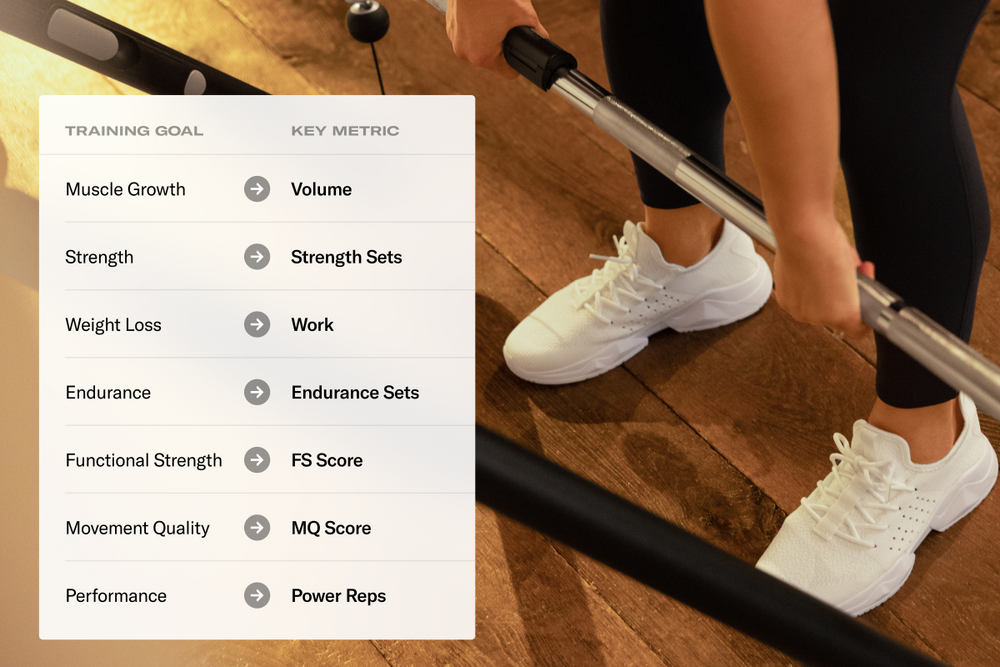Tonal’s New Drop Sets Feature Helps You Build Muscle More Efficiently

Get all the benefits of Drop Sets, an advanced lifting technique, with no guesswork or extra equipment.
The time-saving benefits of drop sets, in which you gradually reduce the weight as you approach failure, aren’t new to experienced lifters. It’s a proven technique to build muscle efficiently, but it typically requires a lot of planning and equipment—like an entire rack of dumbbells. Now with the new Drop Sets feature on Tonal, you can easily take advantage of this advanced lifting strategy and start seeing muscle gains faster without the hassle. The Drop Sets feature is available on both Tonal 1 and Tonal 2.
What Are Drop Sets?
In a traditional drop set, you lift a certain weight until you’re near failure and then continuously lower the resistance, lifting until you can’t perform any more reps. Compared to straight sets, in which you complete a set number of reps with the same resistance throughout, drop sets involve performing more reps close to failure in less time. Research shows that these near-failure reps are the ones that recruit higher threshold motor units and therefore are most effective at stimulating hypertrophy, or muscle growth.
“Drop sets give you a lot of hypertrophy stimulus in a short period of time,” says Troy Taylor, Vice President of Performance Innovation at Tonal. “It’s very fatiguing in the moment so it’s time-efficient.”
Drop sets also allow you to accumulate more muscle-building volume in each session without having to add in extra sets or rest periods. In a straight set, you might stop after reaching failure in eight reps, but with drop sets, you’ll lower the weight and push through a few more reps, which adds up to more overall volume within a single set.
At the gym, this might look like “running the rack,” or starting an exercise with one set of dumbbells and then switching to lighter and lighter weights until you reach failure. Alternatively, if you’re doing a bench press, you’d have a gym buddy manually taking plates off the bar as you go.
On Tonal, the Drop Sets feature automatically lowers the weight so you don’t need a whole gym’s worth of equipment—or a very patient spotter—to supercharge your hypertrophy; and in fact, you don’t even need to think about it while you’re performing your set.
Note that Drop Sets are one of three set types (the other two being reps and duration); it isn’t a dynamic weight mode like Eccentric or Chains. The distinction here is that set types reflect the goal of the set, while weight modes reflect the weight feel during each rep.
How Does Tonal’s Drop Sets Feature Work?
When you use the Drop Sets feature in coach-led content on Tonal, you’ll start with a calibration set to ensure that you’re starting at the correct resistance to get the most out of your workout. Although Tonal already personalizes your weight for every set, research shows that your strength can vary as much as 18% day-to-day. So if you’ve had a bad night sleep or are feeling especially energized, you’ll want your starting drop set weight to reflect that to ensure your workout is as efficient as possible.
The calibration set is for eight reps. However, you want to lift until you have just about one or two reps in reserve—meaning that you could do one or two more reps before feeling tapped out. So on a good day, that might mean you do 12 or 14 reps on your calibration set, which will then tell Tonal to set your Drop Set starting weight higher in order to help you get closer to failure.
Note that if you add Drop Sets to a Free Lift or Custom workout, there won’t automatically be a calibration set. You can always add a set of eight reps and to prime your muscles and make sure the weight is sufficiently challenging before activating Drop Sets.
On your drop set, Tonal sets the resistance to one that should bring you to failure by eight reps. As Tonal senses your velocity starting to decrease, it will slightly reduce the weight so you can keep repping it out. This process repeats until you’ve reached a maximum of four weight drops and at least 20 completed reps. If Tonal senses that you are at true muscular failure, it will turn the weight off and end your set.
By doing so, Taylor explains that the Drop Sets feature “maximizes the number of hypertrophy-stimulating reps by allowing you to do more reps closer to failure.”
This is also what differentiates the Drop Sets set type from Tonal’s Burnout mode, a dynamic weight mode designed to lower the weight when you pause during a set so you can complete a set number of reps or duration. With Drop Sets, Tonal drops the weight more regularly when you’re near failure but before you’ve actually failed. You control when Burnout mode is activated, while Tonal controls the weight drops during Drop Sets.
“Tonal’s innovative technology adapts to the speed of every rep, making Drop Sets a powerful tool for muscle growth,” says Zach Lebovics, Senior Staff Product Manager at Tonal. “By incrementally reducing resistance based on your proximity to failure, Drop Sets help you maximize the number of reps that contribute the most to building muscle. In contrast, Burnout detects pauses in your sets and provides support to ensure you safely complete your set.”
Note that with the Drop Sets feature you always have the option to manually stop the set yourself by clicking off the weight.

What Are the Benefits of the Drop Sets Feature?
By automating the process of reducing weight during a set, Tonal’s Drop Sets feature is even more efficient and personalized than trying to do drop sets on your own.
At the gym, it’s up to you when to reduce the weight in a drop set and if you’re not attuned to what approaching failure feels like, you might wait too long or lower the resistance too quickly. Tonal takes the guesswork out of drop sets by gauging your velocity, force, and position in real-time to determine when to drop the weight, Taylor explains.
Tonal’s one-pound resistance increments also make for more effective drop sets as most dumbbell sets have weights that go up by five or ten pounds, forcing you to go too light, too soon. This might mean doing more reps than necessary since a big drop could take you out of that near-failure sweet spot of accelerated muscle gain.
“We get you close to failure and then drop it just enough so you can get a couple more reps in and stay close to failure because those reps are the ones that are most effective at stimulating hypertrophy,” says Taylor.
Finally, since Tonal continuously adjusts the weight, there’s no downtime where you’re re-racking dumbbells and picking up a new set. This can cut several minutes from your workout and minimizes recovery time. To optimize this benefit, Taylor advises to follow Coach Ackeem Emmons’s signature advice: “Once you start, don’t stop.” Pausing too long between reps can give your muscles time to recover when you really want them to reach failure quicker.
How Should You Use the Drop Sets Feature?
Choose coach-led workouts and programs that incorporate Drop Sets or program it on your own in Free Lift or Custom workouts by choosing the Drop Sets set type when you add a move. As the goal of drop sets is to work near failure, it shouldn’t be surprising that these sets are challenging and will leave your muscles shaking. Therefore, you’ll want to add drop sets into your training sparingly at first as you get used to this type of lifting.
“They are quite fatiguing so you want to dial in your dosage,” says Taylor. “You don’t want to just jump into doing a bunch of them. There’s a lot of neuromuscular fatigue that happens.” For big compound lifts, like bench presses and squats, where your form may struggle under fatigue, he recommends performing one to two drop sets per week. Isolation exercises, such as biceps curls and triceps extensions, can be done as drop sets more frequently.
If your training time is very limited, you can build up to using the Drop Sets feature in every workout to maximize efficiency. Since you’ll be doing more work close to failure, your workouts will feel more challenging but you’ll be able to fit more hypertrophy stimulus in less time.
Alternatively, Taylor explains that you can use Drop Sets as a “finisher.” After completing a certain number of straight sets, add in a drop set to ensure you reach fatigue and build more muscle.
To experience the Drop Sets feature in action, try some of these new coach-led workouts that incorporate this set type or search “Drop Sets” on the Trainer or app for more options:
Related stories

- PRODUCT
Introducing New Metrics For Your Training Goals
Tonal's nkey metrics and personalized targets help unlock better fitness outcomes. Here's what you need to know.
Read more
- TIME
- WORKOUTS
Supercharge Your 2025 Fitness Goals with Four-Week Fast Track: Accelerate
Jumpstart your year by improving your all-around fitness and accelerate crushing your goals with this January workout challenge.
Read more
- NUTRITION
Expert Nutrition Guide Helps You Maximize Your Muscle Gains
Tonal has teamed up with fitness coach and body recomposition expert Chris Barakat to create a customizable, protein-packed nutrition guide.
Read more- NUTRITION